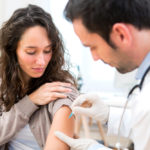Psoriasis vulgaris is also called plaque psoriasis or “common” psoriasis. It is the most common form of psoriasis with 80 to 90 percent incidence.
Skin areas affected by psoriasis vulgaris appear thickened, are reddened and covered with silvery white scales. Severe burning and itching as well as painful cracks on the skin surface often accompany psoriasis.
In this article you will find answers to the most important and most frequent questions:
- What is psoriasis vulgaris?
- What are the symptoms of psoriasis vulgaris?
- Where does psoriasis vulgaris occur most often?
- What forms of psoriasis vulgaris are there?
- What are the causes of psoriasis vulgaris?
- What therapy helps with psoriasis vulgaris?
- Which accompanying diseases can psoriasis vulgaris cause?
What is psoriasis vulgaris?
Psoriasis vulgaris is the most common form of psoriasis, a chronic inflammatory skin disease in which the immune system attacks the body’s own healthy tissue, causing inflammation.
During the subsequent healing process, the body stimulates an excessive production of new skin cells. This overproduction leads to thickening and to neighboring skin cells sticking together and forming so-called plaques. These plaques can be recognized as inflamed skin areas, covered with silvery white scales.
Overall, 80 to 90 percent of those affected by psoriasis suffer from psoriasis vulgaris, the so-called plaques psoriasis or “ordinary” psoriasis.
Plaques psoriasis occurs preferentially on the extensor sides of the elbows and knees. It often extends to other parts of the body such as ears, hands, back and head.
As a systemic disease, psoriasis vulgaris affects the entire body and increases the risk of accompanying diseases such as metabolic disorders, cardiovascular diseases and psoriatic arthritis.
What are the symptoms of psoriasis vulgaris?
You can recognize psoriasis vulgaris by the following symptoms:
- Sharply defined, thickened skin areas,
- Inflamed and reddened skin surface,
- Silvery white scales (plaques) covering the affected skin areas,
- Severe burning and itching of the skin change and/or
- Painful cracks on the affected skin areas.
Where does psoriasis vulgaris occur most frequently?
Psoriasis vulgaris occurs particularly frequently in the following parts of the body:
- Extensor sides of the extremities, especially elbows and knees,
- Hairy scalp (psoriasis capitis),
- Ears and/or
- Back.
In addition, the palms of hands and feet are often affected, as well as pronounced skin folds, for example under the chest or in the groin. Psoriasis vulgaris is particularly painful when the anal or genital area is affected.
50 percent of all psoriasis vulgaris patients suffer from changes (such as discoloration, deformation) in the fingernails and toenails.
Forms of psoriasis vulgaris
Doctors basically divide psoriasis vulgaris into two forms:
Psoriasis type 1
- Early type
- Occurs before the age of 40.
- Frequency psoriasis type 1: 60 to 70 percent
- Genetic predisposition due to family predisposition likely.
- Often a rather severe course of the disease.
Psoriasis type 2
- Late type
- Occurs after the age of 40.
- Frequency psoriasis type 2: 30 to 40 percent
- Genetic predisposition unlikely as there is seldom a family cluster.
- Usually a rather mild course of the disease.
In addition, two subtypes result based on the symptoms and the course of the disease:
- Chronic stable psoriasis vulgaris (chronic course) and
- Acute eruptive psoriasis vulgaris (course of the disease is intermittent).
Causes of psoriasis vulgaris
The investigation of the causes of psoriasis vulgaris has not yet been fully completed. However, scientists and doctors agree that it is an interaction of two factors: genetic predisposition and so-called triggers.
The genetic predisposition or tendency to psoriasis vulgaris is inherited. However, the disease does not automatically occur in everyone who has this predisposition.
As a rule, so-called triggers are responsible for the onset of the disease. Triggers are activating factors that differ from person to person. Known triggers of psoriasis vulgaris are
- Infections (especially respiratory diseases, streptococci),
- Medication (beta blockers, lithium),
- Injuries to the skin (burns, cuts, operations, tattoos),
- Drinking,
- Stress/emotional load and
- Climatic factors (often sensitivity to cold).
Psoriasis vulgaris has many faces, true to the motto “Everyone has their own psoriasis”.
The form, course, characteristics and therapy of this disease are highly individual. Treatment must also be adapted to your individual needs.
The triggers are just as individual. What applies to an affected person does not apply to you.
Which therapy helps with psoriasis vulgaris?
Psoriasis vulgaris, just like psoriasis in general, is genetically predisposed and therefore not curable, but nowadays it can be treated well.
There are numerous therapeutic options and approaches to treating this disease. It is important that your dermatologist adapts the treatment individually to your skin needs, the shape and the characteristics of your psoriasis.
An early diagnosis is the basis for this, as is your attention to the course of the disease and external influences such as trigger factors.
Local therapy for all degrees of psoriasis vulgaris
As part of the local therapy, you treat your psoriasis with externally acting medication in the form of creams, ointments, lotions, bath additives and shampoos.
The aim of local therapy is to relieve the symptoms, inflammation and itching and to prevent new attacks.
Together with your dermatologist, you have the opportunity to choose the best therapy for you from a range of proven active ingredients and preparations, including:
- Steroid creams,
- Salicylic acid,
- Coal tar,
- Retinoids,
- Calcipotriene (a form of vitamin D) and
- Anthralin.
Even in times without symptoms, it is important that you always pay attention to good basic skin care as a preventive measure.
Light therapy for psoriasis
UV radiation in the form of sunlight or infrared rays has a positive effect on psoriasis in most affected people. The vitamin D3 that our skin produces during the treatment is soothing to inflammation and thus helps to counteract psoriasis vulgaris.
Laser therapy for psoriasis
During treatment with laser therapy, the doctor directs bundled light beams directly onto the affected skin areas. Compared to conventional light therapy, laser therapy specifically bypasses healthy skin areas. This reduces both the risk of skin cancer and the probability of side effects.
Systemic therapy for psoriasis vulgaris
If you have moderate to severe psoriasis, your dermatologist will give you medication in the form of injections, tablets or infusions in addition to local therapy.
Preparations that are used for systemic therapy are, for example
- Methotrexate,
- Ciclosporin,
- Fumaric acid ester,
- Retinoids or
- Biologics.
Preventive measures for psoriasis
Psoriasis is not curable, but the more you know about the disease, the easier it will be to live with psoriasis.
Apart from medication and creams, you have the opportunity to change other areas in a self-determined way. The goal is to get a better long-term grip on psoriasis, its symptoms and effects. This includes:
- Relaxation techniques
Stress is a factor that often has a strong negative impact on the outbreaks and symptoms of your psoriasis. Therefore, find a way to reduce stress and avoid it if possible. Numerous relaxation techniques such as yoga, autogenic training or walks in nature can help you do this.
- Healthy lifestyle
Numerous scientific studies have shown that a healthy diet, sufficient physical exercise and abstention from alcohol and cigarettes have a positive effect on the frequency and severity of psoriatic attacks.
- Conscious nutrition
A connection between psoriasis and nutrition has not yet been sufficiently researched and confirmed.
However, many people affected report that a healthy diet has a positive effect on their skin in the case of psoriasis. However, certain foods, such as processed meat and sugar, are clear triggers (triggers for relapses).
Which accompanying diseases can be caused by psoriasis vulgaris?
Patients with psoriasis vulgaris have a two to four times higher risk of other diseases.
Common concomitant diseases of psoriasis vulgaris are
- Psoriatic arthritis (psoriasis with joint involvement),
- Diseases of the cardiovascular system (heart attack, stroke, atherosclerosis, high blood pressure),
- Metabolic diseases and disorders (diabetes, obesity),
- Autoimmune diseases (Crohn’s disease, gluten intolerance) and
- Anxiety disorders and depression.
Affected persons withdraw more and more from society, often from fear and shame, especially through accompanying mental illnesses such as depression.
The exchange with other affected persons can help you to better cope with your psoriasis. You will also see that you are not alone – our Facebook group is the ideal place to meet!
Conclusion: Psoriasis vulgaris – a disease with many faces
Psoriasis vulgaris is the most common form of psoriasis with about 80 to 90 percent. Colloquially, it is therefore called “common” psoriasis.
As a chronic inflammatory skin disease, psoriasis vulgaris is not curable, but often easily treatable.
It is important for you as a sufferer to be familiar with the disease, its causes, its course and possible therapeutic approaches.
It is equally important to know what has a positive and negative effect on your skin and possible psoriasis attacks. This includes not only medication, but also factors such as stress and nutrition.
Hopefully, this article will provide you with many answers to your questions. Now we would be happy to learn more about you. How do you manage your life with psoriasis vulgaris? Which therapy has had the desired effect on you?
Click here, then you will find all references
Sources:
– Website of the Psoriasis Research and Treatment Centre Charité – University Medicine Berlin. URL:http://psoriasis-charite.de/Was_ist_Psoriasis/krankheitsbild/formen-der-psoriasis.html. Access on 26.02.2019.
– Altmeyer P: Psoriasis palmaris et plantaris. In: Online-Enzyklopädie der Dermatologie, Venerologie, Allergologie und Umweltmedizin. URL:http://www.enzyklopaedie-dermatologie.de/artikel?id=3359. accessed 02-26-2019.
– Arbeitsgemeinschaft der Wissenschaftlichen Medizinischen Fachgesellschaften e.V. (AWMF): Leitlinie zur Therapie der Psoriasis vulgaris, Download: http://www.awmf.org/uploads/tx_szleitlinien/013-001l_S3_Therapie_Psoriasis-vulgaris_2017-12.pdf. Access on 26.02.2019.
– Mason AR, Mason J, Cork M, Dooley G, Hancock H. Topical treatments for chronic plaque psoriasis. Cochrane Database Syst Rev 2013; (3): CD005028.

Bernd is one of the founders of Simply Psoriasis. He has been suffering from psoriasis for more than 20 years, but sees the chronic skin disease with more composure than a few years ago (which was a hard work). Nevertheless, he is very keen to make psoriasis easier and more socially accepted.









Last Comments